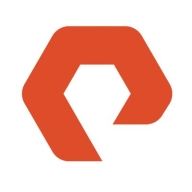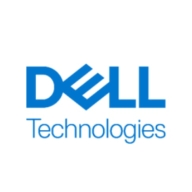


Find out what your peers are saying about Red Hat, Dell Technologies, Nutanix and others in File and Object Storage.
It does not require much management once you set up correctly, so it saves time, allowing an admin to focus on other work.
I have seen both time savings and cost savings, so there is definitely a return on investment with Dell ECS, along with peace of mind.
With OpenShift combined with IBM Cloud App integration, I can spin an integration server in a second as compared to traditional methods, which could take days or weeks.
Moving to OpenShift resulted in increased system stability and reduced downtime, which contributed to operational efficiency.
It is always advisable to get the bare minimum that you need, and then add more when necessary.
I would rate them an eight out of ten.
The support is done through email and is not that great, making it a very problematic area I've been dealing with for over four years.
Their technical support has been perfect lately, so I would give it a 10.
There is a lack of SUSE Linux experts which affects the level of support.
The response time and quality of the technical support are satisfactory.
Customer support is generally good but sometimes struggles with complex issues.
Red Hat's technical support is responsive and effective.
I have been pretty happy in the past with getting support from Red Hat.
Red Hat's technical support is good, and I would rate it a nine out of ten.
Pure Storage FlashBlade is scalable.
There are between 5 and 10,000 people using it in our organization.
Through the fabrics, it provides the clustering, allowing us to add nodes easily.
It allows scale-out processes by adding extra nodes, providing flexibility for customers to increase capacity on demand.
I would rate scalability between eight or nine, as it provides a good ability to scale and expand storage.
The on-demand provisioning of pods and auto-scaling, whether horizontal or vertical, is the best part.
OpenShift's horizontal pod scaling is more effective and efficient than that used in Kubernetes, making it a superior choice for scalability.
Red Hat OpenShift scales excellently, with a rating of ten out of ten.
In case there is any issue with any blade, the data is moved to another.
We have not experienced any outages in the last four years.
We use it in very critical areas inside Saudi Arabia with critical customers.
I'd rate stability maybe 9.5 out of ten.
It provides better performance yet requires more resources compared to vanilla Kubernetes.
I've had my cluster running for over four years.
It performs well under load, providing the desired output.
Technical support definitely needs significant improvement.
Its configuration should be easier.
One way Pure Storage FlashBlade can be improved is by having more compatibility between the FlashArray and FlashBlade.
Live logs should be viewable through the GUI like with Logstash or Elasticsearch.
The deployment is not easy, and some expertise is required to configure the virtual data center and replication groups.
Incorporating extra integrations beyond S3, like Hadoop file systems, and being well aligned with trends like AI solutions would be beneficial.
Learning OpenShift requires complex infrastructure, needing vCenter integration, more advanced answers, active directory, and more expensive hardware.
Red Hat OpenShift's biggest disadvantage is they do not provide any private cloud setup where we can host on our site using their services.
We should aim to include VMware-like capabilities to be competitive, especially considering cost factors.
The pricing of Pure Storage FlashBlade is expensive compared to other products I used from other companies in the past, but one benefit is that they have built-in ransomware protection.
Regarding pricing, it is okay; we needed exactly this in size, and the price was a lot lower than competitors, making it good for us.
It relies on nearline SAS drives, which are cheaper than flash or SSDs.
The pricing model is on the higher side compared to other vendors.
The price is reasonable given the abundance of features, including managing, control, host resources, dockers, and containers.
Initially, licensing was per CPU, with a memory cap, but the price has doubled, making it difficult to justify for clients with smaller compute needs.
Red Hat can improve on the pricing part by making it more flexible and possibly on the lower side.
The cost of OpenShift is very high, particularly with the OpenShift Plus package, which includes many products and services.
We can plug in many blades, and we can have data up to one terabyte.
The best features of Pure Storage FlashBlade include better throughput and better performance.
Pure Storage FlashBlade's scalability is one of the most valuable features, and importantly, it always works, allowing for seamless upgrades.
The stability of this solution is a major advantage, as we've not experienced any outages in the last four years.
Dell ECS helps with managing storage requirements since it's S3 kind of object storage with all needed enterprise features such as immutability, snapshotting, and application management, which are nice sets of features usually required.
The impact of Dell ECS on my organization has been positive, improving user experience, security, and reliability.
Because it was centrally managed in our company, many metrics that we had to write code for were available out of the box, including utilization, CPU utilization, memory, and similar metrics.
The concept of containers and scaling on demand is a feature I appreciate the most about Red Hat OpenShift.
A valuable feature of Red Hat OpenShift is its ability to handle increased loads by automatically adding nodes.
| Product | Market Share (%) |
|---|---|
| Dell ObjectScale | 7.0% |
| MinIO | 17.4% |
| Red Hat Ceph Storage | 16.7% |
| Other | 58.900000000000006% |
| Product | Market Share (%) |
|---|---|
| Red Hat OpenShift | 6.4% |
| Azure Stack | 22.0% |
| VMware Cloud Foundation | 18.9% |
| Other | 52.7% |



| Company Size | Count |
|---|---|
| Small Business | 11 |
| Midsize Enterprise | 11 |
| Large Enterprise | 21 |
| Company Size | Count |
|---|---|
| Small Business | 12 |
| Midsize Enterprise | 12 |
| Large Enterprise | 11 |
| Company Size | Count |
|---|---|
| Small Business | 17 |
| Midsize Enterprise | 4 |
| Large Enterprise | 40 |
FlashBlade is the industry’s most advanced scale-out storage for unstructured data, powered by a modern, massively parallel architecture to consolidate complex data silos (like backup appliances and data lakes) and accelerate tomorrow’s discoveries and insights.
Dell ObjectScale is a next-generation S3 object storage platform known for scalability, performance, and efficiency. It integrates with Dell EMC products, combining hardware and software for seamless user experience in the AI era.
Dell ObjectScale implements the S3 protocol, integrating smoothly with Dell EMC solutions like ISILON. Its architecture supports data compression and interoperates with multiple protocols for enhanced performance. Enterprise features include immutability, geo-replication, and user-friendly management. However, it needs better integration with other systems, enhanced security, and disaster recovery. Write performance and scalability improvements, competitive pricing, and documentation enhancements are key areas for progress. The interface could be more straightforward, with more remote management features and native analytics.
What features does Dell ObjectScale offer?Industries leverage Dell ObjectScale for cloud-based object storage, archiving, and backups. It's favored for unstructured data management, CCTV integration, and document archiving. Strong in data analytics, it integrates well with high-capacity applications, enhancing data retention strategies across fields.
Red Hat OpenShift offers a robust, scalable platform with strong security and automation, suitable for container orchestration, application deployment, and microservices architecture.
Designed to modernize applications by transitioning from legacy systems to cloud-native environments, Red Hat OpenShift provides powerful CI/CD integration and Kubernetes compatibility. Its security features, multi-cloud support, and source-to-image functionality enhance deployment flexibility. While the GUI offers user-friendly navigation, users benefit from its cloud-agnostic nature and efficient lifecycle management. However, improvements are needed in documentation, configuration complexity, and integration with third-party platforms. Pricing and high resource demands can also be challenging for wider adoption.
What are the key features of Red Hat OpenShift?Red Hat OpenShift is strategically implemented for diverse industries focusing on container orchestration and application modernization. Organizations leverage it for migrating applications to cloud-native environments and managing CI/CD pipelines. Its functionality facilitates efficient resource management and microservices architecture adoption, supporting enterprise-level DevOps practices. Users employ it across cloud and on-premises platforms to drive performance improvements.
We monitor all File and Object Storage reviews to prevent fraudulent reviews and keep review quality high. We do not post reviews by company employees or direct competitors. We validate each review for authenticity via cross-reference with LinkedIn, and personal follow-up with the reviewer when necessary.